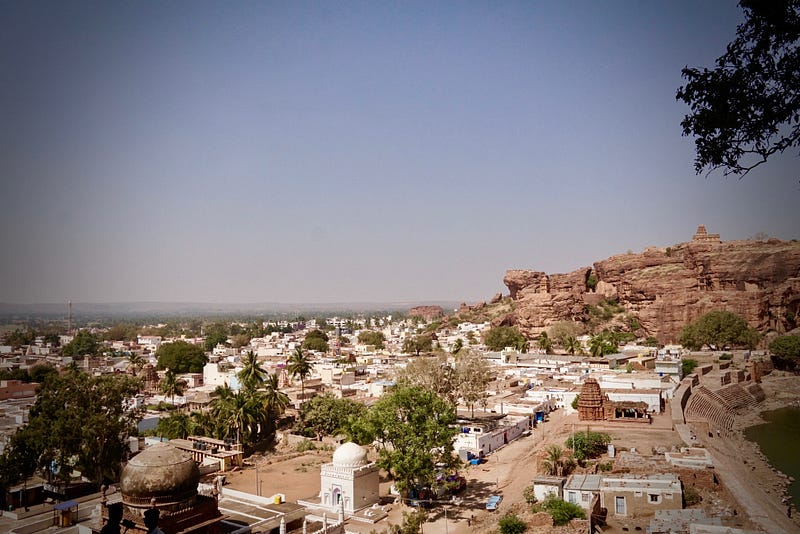 |
The town of Badami situated adjacent rock cut Hindu temples carved a millennia ago from surrounding sandstone hills.
|
A distant but loud human voice assails my comatose self…allah u akbar... it calls out and then repeats. Turning over, I try to grasp, and am presently confused. This is not a sound I’m used to hearing at 6 am in the morning. Dreaming, am I? Go away. I tightly press the brick hard motel pillow against my ears. It grows faint and eventually recedes. Just a few mins hence I hear bells ringing…clang, clang! There is no ’snooze’ button that I can find and the sounds will not go away. What, is this now? I groggily sit upright and see Mohit, my roommate and trip partner look dazily look back at me from the adjacent bed. It kind of hits both of us at the same time. We just got roused by the muezzin call to prayer, quickly followed by puja bells from a nearby Hindu temple. We must indeed be in India.
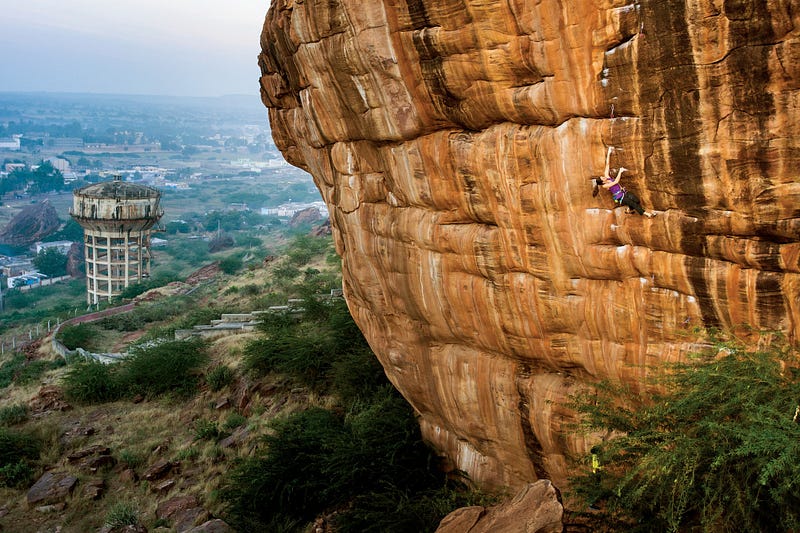 |
| Paige Classen making the FFA of Ganesha, 14a, the route that has recently brought new attention to Badami. Photo credit: Jon Glassberg |
Tucked away, in a corner of the Southern state of Karnataka, we are in Badami, a forgotten little town, known for ancient Indian rock temples, and amongst rock worshippers, for high quality single pitch sandstone sport climbing. Even here in this dusty corner of a vast country India’s secular roots feel strong, with both Hindu and Muslim faiths in vibrant co-existence. We fight the instinct to go back to sleep as the room fills up with light as the sun makes a lazy appearance.
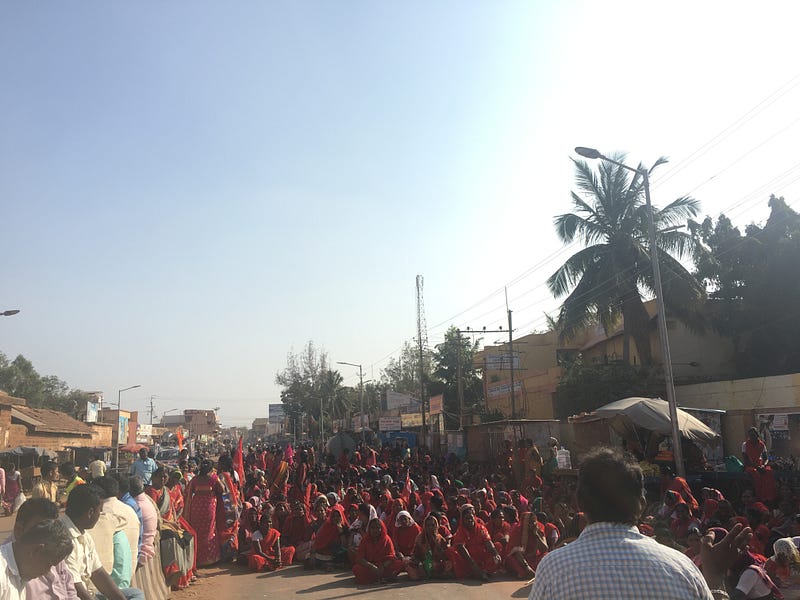 |
| One day we found the road blocked by a large group of women protesting some local government policy. India is a democracy and proudly so |
I had been mulling a trip to climb in Badami since 2008 when I first visited Hampi, its more famous neighbor next door for some world class bouldering (highly recommended as well!). Badami knocked on my senses again when I saw a spectacular video of Gerome Pouvreau’s ascent of Ganesha. A visit to India was already taking shape with a family wedding in the horizon this January. Mohit’s invite to join a trip to Badami occurring just a couple of weeks prior was a perfect opportunity to throw some adventure and enrich an already long commute across the seas.
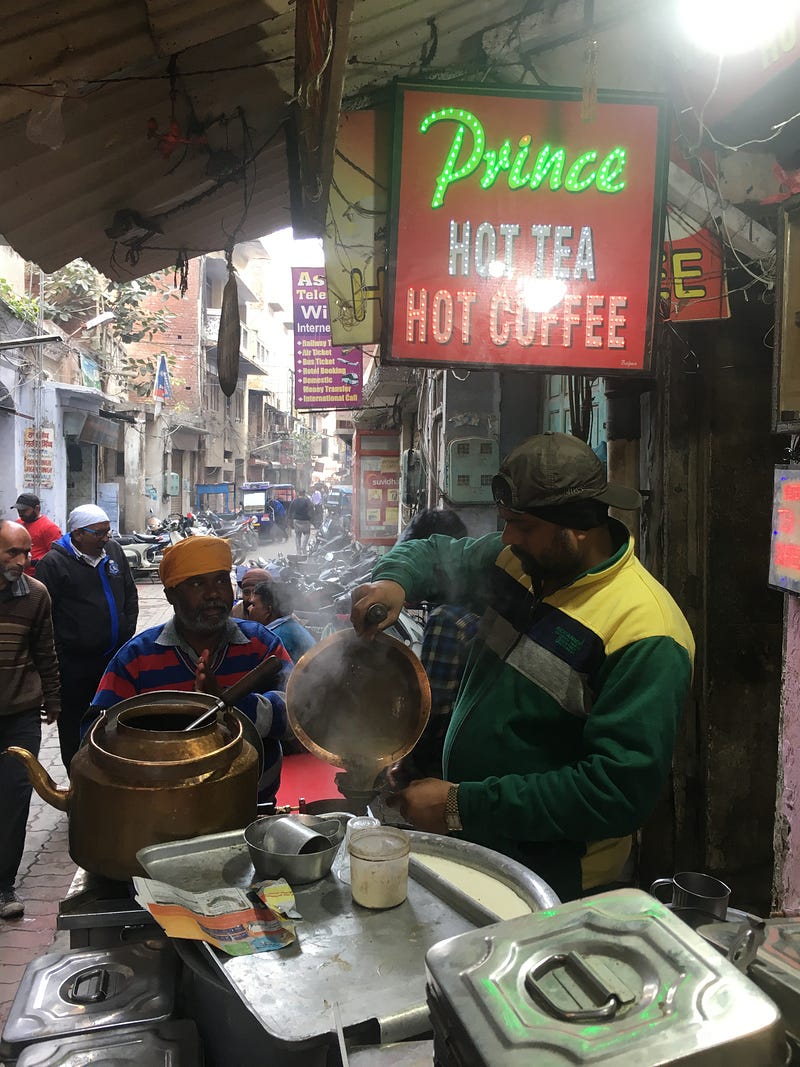 |
| Tea is to be found everywhere in India, and is relatively safe to drink as the boiling process kills harmful microbes. |
A few hours later, fed by a satisfying breakfast of idlis and bottomless chai, we find ourselves at the Ganesha Plateau area. Situated on a vast plateau overlooking the main town, there are endless sandstone bluffs with only a few of the cliffs bolted so far. We are led by Ravi, a talented local climber and our guide for the day. Rounding a few corners we find ourselves in a serene gully with 50–100 foot vertical to slightly overhanging walls on both sides. Identifying a few warmups, we get our gear sorted and slowly start limbering up a few 5.9–5.10 graded routes behind, and in front of us. Though we’ve been up for a while, it’s barely 9 am, the air is still cool and we opt to climb on the sunnier wall before heat from the rising sun will force us to seeking coolness in the shade. I’m glad that the intro routes are on the easier side of the scale. I did not sleep well and also am recovering from jet lag and long travel. My body still feels on California time (13.5 hours behind India), and it has taken multiple flights, taxis, and tuk tuk rides to finally make it here. A few routes in towards mid-day we break to snack on grapes and papaya, and I find the travel fatigue receding and I start to relax into my present self.
 |
| Warmups underway at Ganesha Plateau crag |
Next, we turn our attention to some harder routes on the right-facing wall as our muscles start to loosen and we start finding our rhythm. Without an updated guidebook handy we are glad to have routes and grades pointed out to us. The website The Crag does have a topo for the area but it is not always accurate as it relies on visiting climbers to update, Wikipedia style. The lack of comprehensive data adds to this feeling of adventure, which is sometimes lacking in other more popular climbing destinations that have been ’tamed’ with lavish guidebooks and the ubiquity of information online. At many of these places you can select and plot out your climbs well in advance, and even garner enough beta (knowledge of specific sequences on climbs) for possible flash attempts on famous routes. Case in point, the ‘Age of Ondra’ climbing movie, where pro climber Adam Ondra, finds routes of his target grade at destinations in Europe and Canada, deciphers beta from online resources, and practices the sequences without setting foot on the route. Holy rock climbing!
Back to the now. Shaped and compressed by the elements over the millennia, we find the rock to be reliably robust, and the climbing movement to be fun and reminiscent of Red Rocks and the New River Gorge to me. I adore tick-tacky problem solving through crimps, pinches and slopers on vertical to gently overhanging terrain. Not the style I’m the best but still my favorite. Feeling good after ticking off a number of routes, while admittedly failing on a couple of bouldery ones, we feel we’ve just enough left for one more, and Ravi has just the right suggestion for me. Right around the corner we are guided to a prominent face with two pretty lines of weakness illuminated by ochres hues of the fading sun. French Indian Masala at 12c is too hard for me today, but a few feet over is La vie est Belle (or Life is Beautiful). Quite easier at the grade at 11a/b, but not a slam-dunk, with delicate face and a tricky roof move to surmount before the anchors. A five star route! I’m relieved to successfully clip the chains to end a fine first day of climbing. The sun is now almost below the horizon and I take in one last view for the day around the majestic beauty of the hills, the foliage and the undulating valleys that also inspired one of the famous site locations of Sholay, the cult Bollywood classic from many many moons ago. We pack up our gear and slowly begin the walk back to town. I’ve a chance to reflect…ahh, back in India, and practicing my favorite activity in the land I grew up in. This is going to be a great, no, a fantastic trip.
 |
| Mohit executing the final sequences of another nice line |
Badami is a small town with one paved road that connects it from one end to the other. Like many Indian towns of similar stature, the bus stand is the center of the action. It’s a 20 min walk to the crag and we settle into the patio at Golden Caves for a cool down beer with a side of egg bhurji (eggs pan-fried with spices and veggies) Gripping a cold bottle of beer is the best recovery for battle weary hands, take my word! For our first night we opt to head back to our hotel for dinner, The Badami Heritage Resort about 1.5 kms, and a 5 min tuk tuk ride. While the name is an exaggeration, I’d recommend it for a quiet and comfortable place to stay. Next morning we wake up rested and relieved to have slept away from the loud sounds of our previous night. Opening the window shades we find a delightful view of a radiant rock wall across from the hotel, fueling our anticipation for the day.
 |
| Tucking into thalis (Hindi word for a platter of food) end of day. The price? A joke at 1 USD per person with unlimited portions. |
 |
| Cooling the engines with the the mandatory aprés-climb beer. (when in India drink Kingfisher! |
A short tuk tuk ride and a breezy walk finds us at the Temple Crag, named aptly after a famous Hindu temple in its environs. On the way we stop by to gawk at Ganesha, the proud line mentioned above, as well as another couple of projects that may clock in at 14c or so. Awe-struck by these futuristic lines we make our way to the main area and immediately see a dozen or so climbers, and ropes and gear hanging off various routes tightly bunched together. This is a scene that’d be familiar at any crag in the world and we immediately feel at home. We sample some of the warm ups, and I feel inspired to try the Pillar Route, 12c, a striking line that squeezes a blunt arete with a wild looking dyno at the very top. The route is so named that if one top- ropes the line, and comes unglued off the wall early in the route, one may gently smack and hug a stone carved pillar directly behind! Amusing! Fortunately I was on lead, and while I did fall multiple times trying to ‘work’ this route, I avoided any pillar hugging thankfully. While I’m quite out of bouldering shape (or, I suck!), and expectantly fell at the ending dyno move, I did have a lot of fun trying the route. As the grades get harder, I’d say 5.12 and over, the climbing style of the area does get quite bouldery, with powerful cruxes between good rests. However with over 200 currently bolted routes, and a life-time of potential for more, there are still plenty to do at the moderate end of the scale, where general endurance and technique will get you to the top. As the trip wore on, I found myself getting fitter and trying some of the harder lines. No cigar on any notable ones, but plenty of motivation found to train and be battle-worthy on my next trip!
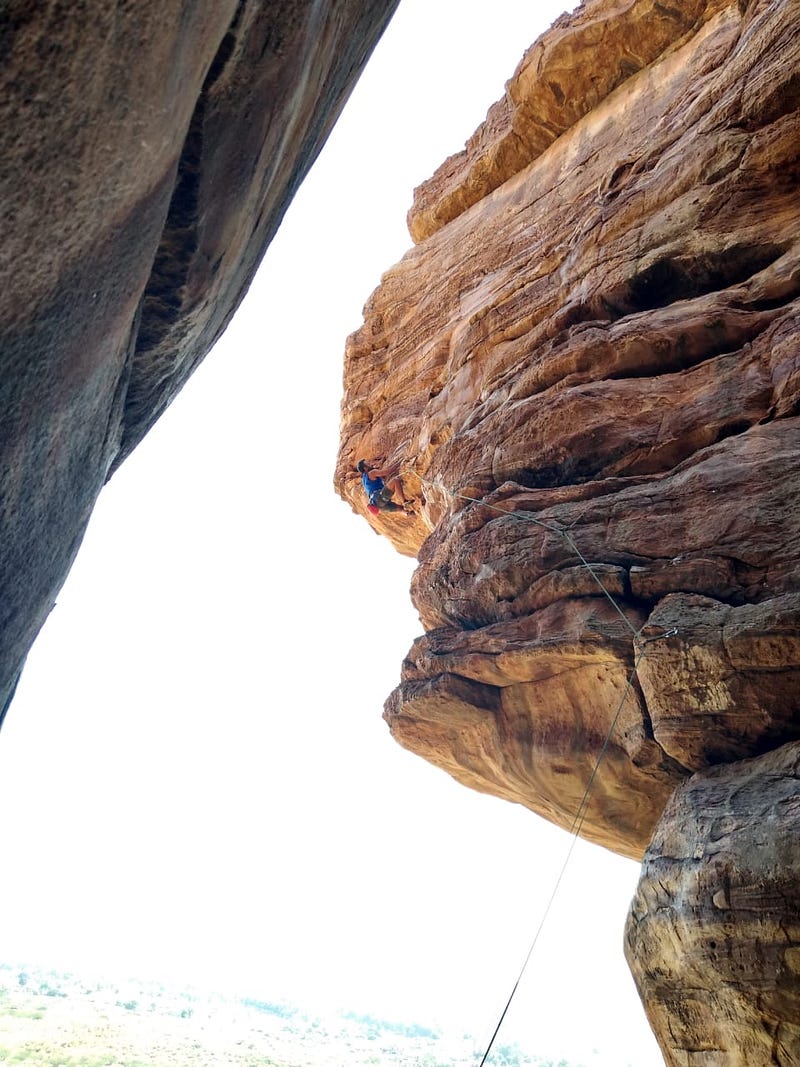 |
| A classic arete route (forgot the name) at Temple Crag. Likely 5.10c-ish |
 |
| The author taking flight from the Pillar Route. The dyno at the end is hard! |
Like in Hampi, Tonsai in Thailand and some of the other climbing spots in Asia, monkeys are everywhere in Badami, including the climbing cliffs. Here however the simians were more aggressive than their brethren elsewhere. We faced constant harassment at the crags and had to band together to guard our belongings as these starving critters followed us with a hawk’s eye, and devised every creative ruse to steal our bags (with the possibility of food inside). We heard that over the past few decades many forests around the original village of Badami had been rapidly replaced with housing and industry, and consequently many of the monkey populations had been forcibly exiled to hideouts in dark rocky recesses around the hills, and their proud diet picking fruit and berries had been replaced with foraging for food scraps. As humanity expands, our physical footprint sadly encroaches on previously wild spaces. As climbers we were inadvertent witness to this dark side of progress.
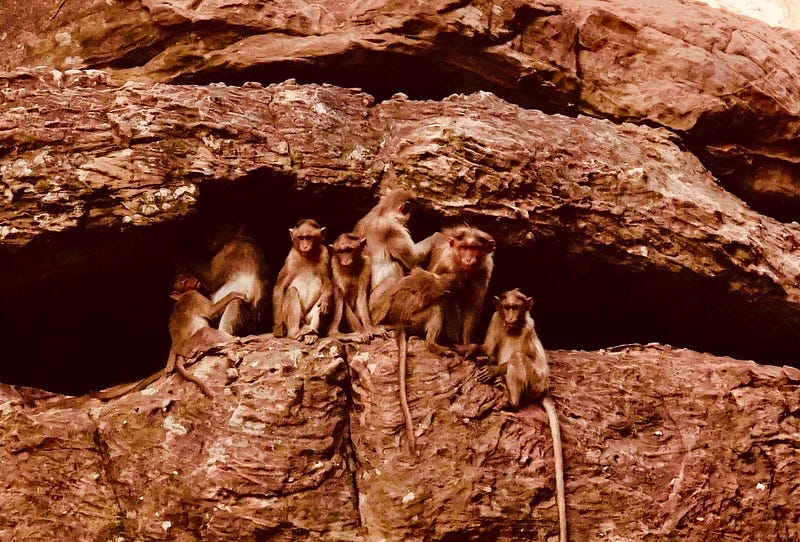 |
This family of monkeys apparently lives in the cave right behind them in this photos. This was at Ganesha Plateau.
|
 |
| Ravi powering his way towards an early ascent on a likely mid 5.12 route at Ganesha Plateau |
We were in Badami just after the new year and apparently just missed a large group of climbers on their way out. Fortunately we made friends with another small and friendly group from New Zealand, US, Europe and of course India. It was fun to discover new restaurants together (and the best dosas around!), do some customary sight seeing, and of course chill and talk more climbing on rest days. While I love the sport and pushing myself on beautiful rock walls, it’s meeting other passionate climbers and the resulting camaraderie that I cherish almost as deeply. You’ve to be a little crazy to find the ’the most difficult way up’ on rock walls in strange lands, and so we are happy to find others who understand us. 🙂
Another beautiful part of traveling for climbing is interacting with the local climbing community and connecting with their life and experiences. This is especially true for ‘under the radar’ areas where the sport hasn’t quite exploded as yet. Many years ago I found an authentic scene in Vinales, Cuba, and now I, found one here. It’s life-affirming to find shared love with the locals.
Ravi, our informal guide during this trip was just another local village kid looking at a bleak future of blue collar work in an impoverished part of the world when climbing found him. With donated shoes and a harness, he, and a few others like him, show visiting climbers around the area and earn a little money to support their climbing habit and feed their family. His unaffected demeanor, humility, and psyche for life is infectious, and it was a treat to spend time with him and ask him to climb with us even after we had learnt our way around the crags. By western (and even Indian urban) standards the guiding fee is a total bargain, as are the other costs of staying in Badami, where meals are just a couple of dollars, and adequate rooms just a few more. Being your typically self-reliant climber, I don’t normally hire a guide but was quite glad of one here, for I learnt so much about the place, its history and the local culture, in a land particularly special to me given my Indian roots.
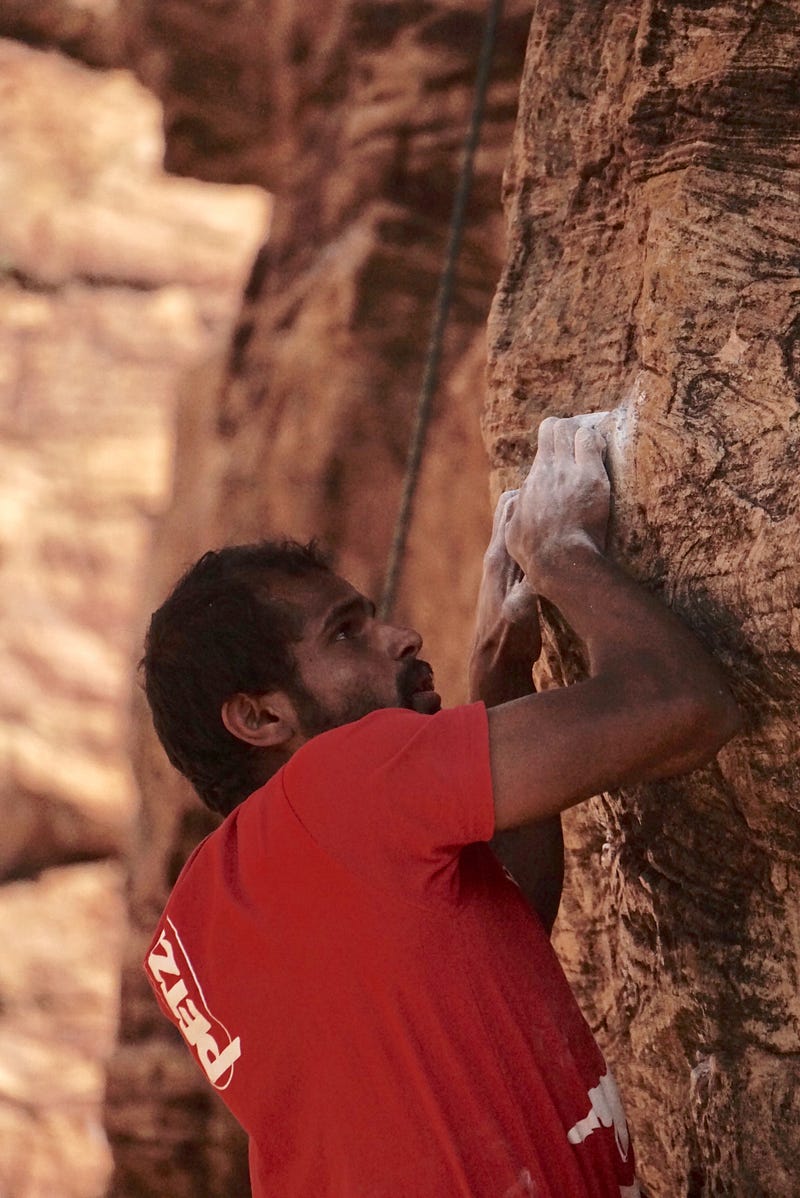 |
One of the strong local guys focused on the next step of a bouldery sequence. Definitely the land of power moves.
|
At the end of a short but memorable eight day stay I found myself leaving with a special relationship. I’ll remember Badami beyond just the rock, the routes, and the enormous thalis (food platters with typically unlimited helpings) we quaffed at the end of each day!
For more pictures and media from Badami and other rad places visit me at on Instagram.
Thank you for sharing this valuable knowledge.
ReplyDeleteI've read a lot of blogs, but I've never seen anything quite like this. Furthermore, I'm grateful for the opportunity to introduce myself through your posts. All you've written has left me speechless. For an instance, I've bookmarked this for future reference because it's still really useful, even after many years.
Rock Climbing in Delhi
Rock Climbing Competition Video
ClimberHarish
Climbing blogger
Thank you for sharing this valuable knowledge.
I've read a lot of blogs, but I've never seen anything quite like this. Furthermore, I'm grateful for the opportunity to introduce myself through your posts. All you've written has left me speechless. For an instance, I've bookmarked this for future reference because it's still really useful, even after many years.
Climbing in India
climbing in Delhi blog
Rock Climbing Videos
Climbing training blog
Thank you for sharing this valuable knowledge.
I've read a lot of blogs, but I've never seen anything quite like this. Furthermore, I'm grateful for the opportunity to introduce myself through your posts. All you've written has left me speechless. For an instance, I've bookmarked this for future reference because it's still really useful, even after many years.
climbing in Delhi
Delhi rock climbing
mountain climbing in Delhi
climbing competition videos
climber Harish